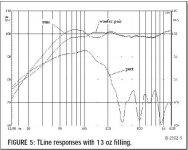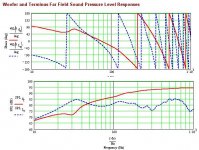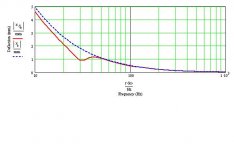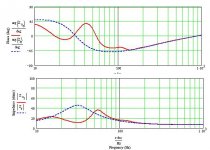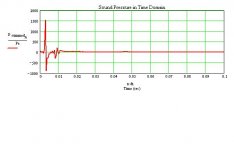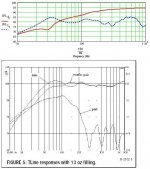Scott,
I looked at the Madisound site, opened the Thor article and reviewed the woofer T/S parameters. I don't see anything that would indicate the driver is not an excellent candidate for a TL. But every once and a while, a particular driver just is difficult to work with and a TL design is not obvious. I have no idea what parameter is causing the problem.
That said, I’ve been fiddling around with different values, and I still can’t hit on anything TL wise that I’d consider building. A TQWT taper appears to be best, but I simply can’t tame that sagging bass below 100Hz with either a conventional taper or straight pipe, leading me to believe that these drivers simply don’t appear to be suited to a TL. Any thoughts Martin?
I looked at the Madisound site, opened the Thor article and reviewed the woofer T/S parameters. I don't see anything that would indicate the driver is not an excellent candidate for a TL. But every once and a while, a particular driver just is difficult to work with and a TL design is not obvious. I have no idea what parameter is causing the problem.
Dave,
Thanks for the positive feedback, it is greatly appreciated.
But we need to recognize that in the world Augspurger, D'Appolito, Dickason, and Dell reside in I am not relevent. Nothing I have done has been subjected to peer review and then published in a formal magazine article or technical society paper. So I am just out there in the mass of the unwashed wannabees called the Internet.
In fact, this months audioXpress contains an article that looks a lot like work I did a few years ago which the author, mentioned in your post above, is now claiming as his own and seems to be patenting. The analogy explaining/demonstating how the enclosure works is very similar to the explanation I provide in my Lowther ML TL documentation in early 2003 and have posted several times on this and other forums.
Martin on the other hand has made his work much more accessible and has continued his research & interaction with others, whereas George has gone onto other things (leaving rick Schultz to explore the space opened up by the GA SW). Martin is to be applauded for continuing to push the frontiers & to dramatically improve our understanding of box design.
Thanks for the positive feedback, it is greatly appreciated.
But we need to recognize that in the world Augspurger, D'Appolito, Dickason, and Dell reside in I am not relevent. Nothing I have done has been subjected to peer review and then published in a formal magazine article or technical society paper. So I am just out there in the mass of the unwashed wannabees called the Internet.
In fact, this months audioXpress contains an article that looks a lot like work I did a few years ago which the author, mentioned in your post above, is now claiming as his own and seems to be patenting. The analogy explaining/demonstating how the enclosure works is very similar to the explanation I provide in my Lowther ML TL documentation in early 2003 and have posted several times on this and other forums.
Scottmoose said:
Well, that pretty much confirms it.
That still looks like a response plot without augmentation by the rear wave exiting the TL. Take a look at the delay. In fact it looks very similar to the response plot for the W18 driver measured anechoicly alone. These measurements I have been told are taken by placing the driver in a 6 litre sealed enclosure. Surely a T/L no matter how badly designed or mismatched should best this.
Take a look at this graph from the AE article. From what I understand - this shows the measured response simulated to anechoic response of the Thor, it combines both port and driver output. It does not include room gain.
If I have misread these please could you explain.
Byrd said:That still looks like a response plot without augmentation by the rear wave exiting the TL.
The ripple in the plot comes from the changing of the phase vrs the front of the driver, so there is no way the plot can be anything but the sum of the responses....
maybe Scottmouse can post the driver & terminus response curves?
dave
Sorry - forgot to include the graph
Dave - I am now quite confused. Could you possibly provide an explanation as to how the attached graph has come about? Is it an in room graph?. If so it is pretty flat.
JDev - Are you refering to the first design - with the 19 Inch (480mm) Depth? How does yours sound now?
Dave - I am now quite confused. Could you possibly provide an explanation as to how the attached graph has come about? Is it an in room graph?. If so it is pretty flat.
JDev - Are you refering to the first design - with the 19 Inch (480mm) Depth? How does yours sound now?
Attachments
Byrd said:Dave - I am now quite confused. Could you possibly provide an explanation as to how the attached graph has come about? Is it an in room graph?. If so it is pretty flat.
The chart i was talking about was the Scottmoose sim... that is one from the aXp article, the one
Scottmoose was complaining about wrt lack of info on how it was generated.
And it is very fishy... how can port output that is some 10 dB down from the main driver output boost total response 3-5 db?
dave
Byrd said:D'Apollito must really have cocked this one up. Is he stupid or just plain useless
I think he was just enticed (by Ed Dell) into doing a speaker in an area he didn't have a whole lot of experience in, was working with really sketchy info and was lured by the siren song of classic design.
dave
Byrd said:JDev - Are you refering to the first design - with the 19 Inch (480mm) Depth? How does yours sound now?
A ha, I was not aware that there are variatons on the design. I used this dimensions. (attached pdf file) Will judge the sound again after some "burn in " time.
So, do you guys actually want to tell me now, that I have just spend a s..t house full of money on an "acclaimed/designed/highly reviewed" speaker , that are actually pretty useless?

How must an uninformed, like me, then choose a "design" if somebody like Byrd don't come along and start asking some valued questions??

Attachments
JDeV said:So, do you guys actually want to tell me now, that I have just spend a s..t house full of money on an "acclaimed/designed/highly reviewed" speaker , that are actually pretty useless?
Only you can decide -- I certainly can't tell you that... i've not heard them. I have just suspected something fishy since i 1st read the article. It will be interesting to hear your comments after you've listened for a while.
dave
Driver & terminus response curves? Your wish is my command Dave. Coming up in the next post. For now, while I wait for my other PC, which has the MathCad curves on, a few other observations. As for the audioXpress graph looking flat, indeed it does look flat. There's a reason for that. First, note how there is nothing even resembling a jagged peak or dip in the plot, indicating smoothing, most likely 1/2 octave. Now observe the 'woofer pair' curve, which is the most relevant one, and how it sags at 100Hz. Finally, note the slight trunkating of the graph, which disguises aberations.
Joe is certainly not stupid, he is one of the great designers of modern times, but however many excuses are made for it, on the lines of 'it doesn't look too bad', Thor is not one of his better efforts. Agreed with the idea that he probably just doesn't have a whole lot of experience with TL design, though, going by the audioXpress article, he went about it in what I would consider a highly amaturish way unworthy of him. Thor's an externally handsome speaker, using some very pretty drivers, which are also very good (OK Martin: I won't give up on them just yet!), but looking at the plot, you can equal or better them in this respect for half the price. Yes, I know, plots aren't everything, but they do tell you a lot. For example that you'll need a massive boost from room gain to get down the the 25Hz frequently mentioned by subjective listeners. Fair enough, I won't argue, but that's the room they're listening to, not the speakers, which is not, in my view, ideal. Thor is a rocky design in my view. But on a positive note, compared to most commercial designs of equivelent price, they're streets ahead. Which just goes to show what a rip off commercial speakers are. It's by no means the worst speaker out there. But it's far from being the best. If you've built them, enjoy them. You've got some terrific drivers in a rather dodgy cabinet (and I hear dark mutterings about the crossover too, but that's for another day). We'll try to come up with something better for them to go in shortly. At least, being MDF, the cabinet isn't overly expensive to make, and represents only a minimal part of the material (if not the time) costs.
You know the old type (pre Martin's MathCad sheets) TL I really admire? Lynn Olson's Ariel. Half the price of the Thor, and a complete pig to build, but it works well for what it is. They don't have low bass, but Lynn never claimed they did. It all seems less pretentious to me somehow. There's art in there, but there's also some good enginnering sense too. Well selected drivers with no break-up modes in the band they're used in, so they require no notch-filters, independent lines for the two Vifa mid-bass drivers in MTM configuration: a little over the top perhaps, but the idea's not without merit. I've built the Ariel, and admire it. The bloke I sold them to was over the moon with them.
By the way Martin, I've just fired a lengthy missive off to Hifi World magazine regarding your work (and a few other things), as I'm frankly apalled at the lack of recognition you've recieved for all your work. OK, so you don't have a famous name like the blokes you've mentioned, but you're the one who came up with a way to model a TL properly, not them. Whether anything'll come of it, I don't know, but they've been running some DIY TL articles of late, most based on the old methods, so with any luck they might decide to read and / or publish it. I wasn't aware that people were deciding to patent 'new' work almost identical to what you'd done years ago. One doesn't know whether to laugh or cry really.
Cheers for now -extra graphs on their way
Best
Scott
Joe is certainly not stupid, he is one of the great designers of modern times, but however many excuses are made for it, on the lines of 'it doesn't look too bad', Thor is not one of his better efforts. Agreed with the idea that he probably just doesn't have a whole lot of experience with TL design, though, going by the audioXpress article, he went about it in what I would consider a highly amaturish way unworthy of him. Thor's an externally handsome speaker, using some very pretty drivers, which are also very good (OK Martin: I won't give up on them just yet!), but looking at the plot, you can equal or better them in this respect for half the price. Yes, I know, plots aren't everything, but they do tell you a lot. For example that you'll need a massive boost from room gain to get down the the 25Hz frequently mentioned by subjective listeners. Fair enough, I won't argue, but that's the room they're listening to, not the speakers, which is not, in my view, ideal. Thor is a rocky design in my view. But on a positive note, compared to most commercial designs of equivelent price, they're streets ahead. Which just goes to show what a rip off commercial speakers are. It's by no means the worst speaker out there. But it's far from being the best. If you've built them, enjoy them. You've got some terrific drivers in a rather dodgy cabinet (and I hear dark mutterings about the crossover too, but that's for another day). We'll try to come up with something better for them to go in shortly. At least, being MDF, the cabinet isn't overly expensive to make, and represents only a minimal part of the material (if not the time) costs.
You know the old type (pre Martin's MathCad sheets) TL I really admire? Lynn Olson's Ariel. Half the price of the Thor, and a complete pig to build, but it works well for what it is. They don't have low bass, but Lynn never claimed they did. It all seems less pretentious to me somehow. There's art in there, but there's also some good enginnering sense too. Well selected drivers with no break-up modes in the band they're used in, so they require no notch-filters, independent lines for the two Vifa mid-bass drivers in MTM configuration: a little over the top perhaps, but the idea's not without merit. I've built the Ariel, and admire it. The bloke I sold them to was over the moon with them.
By the way Martin, I've just fired a lengthy missive off to Hifi World magazine regarding your work (and a few other things), as I'm frankly apalled at the lack of recognition you've recieved for all your work. OK, so you don't have a famous name like the blokes you've mentioned, but you're the one who came up with a way to model a TL properly, not them. Whether anything'll come of it, I don't know, but they've been running some DIY TL articles of late, most based on the old methods, so with any luck they might decide to read and / or publish it. I wasn't aware that people were deciding to patent 'new' work almost identical to what you'd done years ago. One doesn't know whether to laugh or cry really.
Cheers for now -extra graphs on their way
Best
Scott
Hi Scott,
In this case, I can only smile and walk away. But it does start me thinking about how much info I should make avalable when posting any future speaker designs on my site.
I wasn't aware that people were deciding to patent 'new' work almost identical to what you'd done years ago. One doesn't know whether to laugh or cry really.
In this case, I can only smile and walk away. But it does start me thinking about how much info I should make avalable when posting any future speaker designs on my site.
I wasn't aware that people were deciding to patent 'new' work almost identical to what you'd done years ago. One doesn't know whether to laugh or cry really.
I think a letter writing campaign to aXp is called for. Rick has been doing good work with his "TLs for Dummies" series but claiming uniquiness & patent protection is WAY over the top.
Maybe we should start a new thread (when i reviewed his article i complained to him about these comments and said i'd squawk if he kept them in the published article)
dave
Good plan Dave. Consider me behind it 100%.
Martin -I don't blame you. I have benefited in many ways from your work, but never financially. I think you've already guessed my views on that matter. I've seen this sort of thing happen before, in other, non audio areas, and it gets my goat every time.
Why are the simulated and measured outputs different? Well, the curves are basically very similar. Did you remember to apply to the MathCad charts the +6db boost gained in system efficiency for having paralleled drivers when comparing to the measured data?
Regards
Scott
Martin -I don't blame you. I have benefited in many ways from your work, but never financially. I think you've already guessed my views on that matter. I've seen this sort of thing happen before, in other, non audio areas, and it gets my goat every time.
Why are the simulated and measured outputs different? Well, the curves are basically very similar. Did you remember to apply to the MathCad charts the +6db boost gained in system efficiency for having paralleled drivers when comparing to the measured data?
Regards
Scott
- Home
- Loudspeakers
- Multi-Way
- Clarity on Seas Thor Kit
